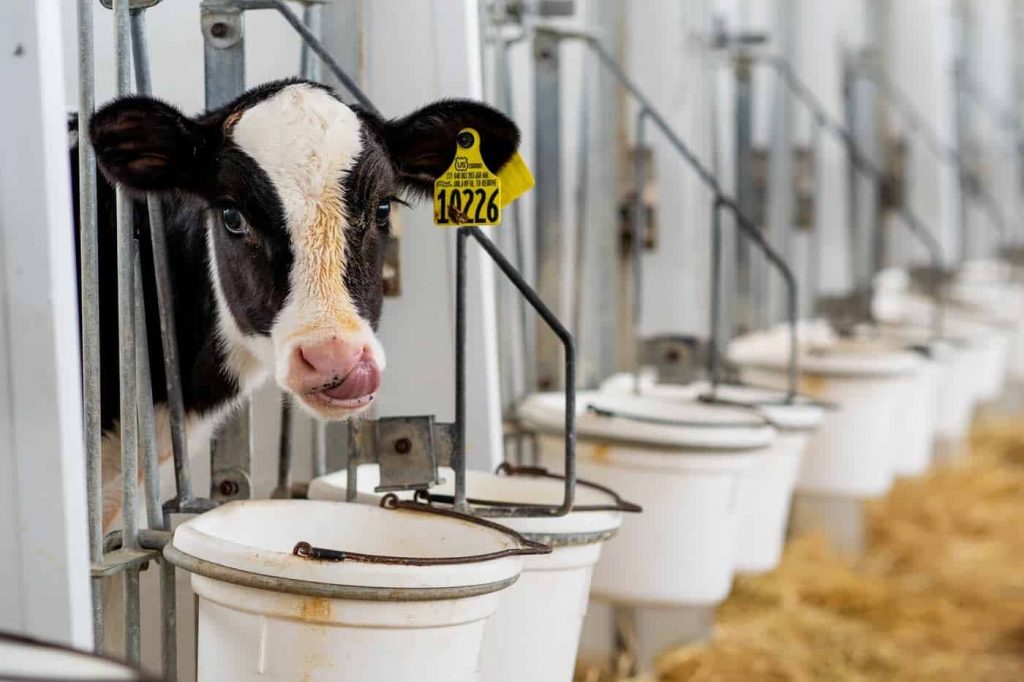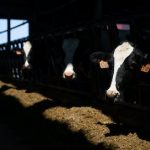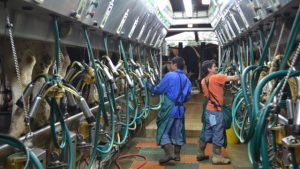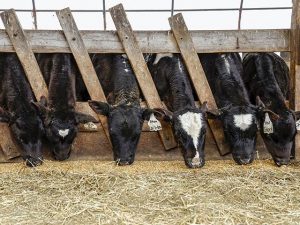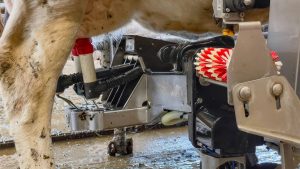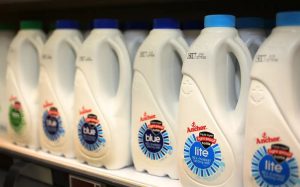
Dairy farmers around the region are facing an oversaturated market. It’s been made worse for some farmers in the region when the Metropolitan Council temporarily cut off sewer service to the Hastings Creamery, after the company was notified of six violations of industrial waste permits including a recent leak of milk into the city’s sewer system.
Now the creamery is hauling wastewater to a plant in St. Paul. The situation is affecting about 45 dairy farmers in Minnesota and Wisconsin. Minnesota Milk Producers Association Executive Director Lucas Sjostrom joined MPR News host Cathy Wurzer to talk about it.
Use the audio player above to listen to the full conversation.
Audio transcript
[MUSIC PLAYING] CATHY WURZER: Dairy farmers around the region are facing an oversaturated market. It’s been made worse for some farmers in the region when the Metropolitan Council temporarily cut off sewer service to the Hastings Creamery. That happened after the company was notified of six violations of industrial waste permits, including a recent leak of milk into the city’s sewer system.
Now the creamery is hauling wastewater to a plant in Saint Paul. This whole situation is affecting about 45 dairy farmers in Minnesota and Wisconsin. Joining us to talk about this is Minnesota Milk Producers Association Executive Director Lucas Sjostrom. Welcome to the program, Lucas.
LUCAS SJOSTROM: Thanks, Cathy. Thanks for having me.
CATHY WURZER: The Hastings Creamery is one of a few options available to dairy farmers in this part of the region. What’s happening for them?
LUCAS SJOSTROM: Well, it’s really a global impact. I mean, 45 farmers are definitely affected, but really we’ve got the whole state and the whole country being surprised by what’s happening at the global scene. I think analysts thought that China was going to come in and be a bigger buyer. At the same time, we’ve got record milk production, relatively at least. This is our spring flush period.
So it’s very normal in May and June that all of our plants are at capacity. And when those things happened at the same time as this Hastings Plant having the situation with Met Council, it just– normally for 100 years, you would always say, well, we’ll find some room in the plant down the road until we get things fixed, but this is just probably the worst time for any of this to happen.
CATHY WURZER: What are dairy operation’s options when their usual processor can’t accept their milk?
LUCAS SJOSTROM: Well, this is a new era. And we at Minnesota Milk are always looking to help encourage more processing in the state of Minnesota, in the upper Midwest region. Before about five years ago and a few blips before that, there was always excess processing capacity. And so, you either belong to a cooperative or you have these patrons, a direct relationship with whoever you ship to, and you assume that’s where the milk is going to go every day or they’ll reroute it if they need to.
And in this situation with a small relative number of patrons with 45, and a problem at the plant, and full milk plants everywhere else, it’s just kind of an unexpected consequence that the market and our regulations aren’t ready for. And we are hoping to put some longer term fixes into place that would help some of these contracting principles, but at the same time, it’s nothing that is going to change overnight. It’s just an unfortunate circumstance.
They have to call around, and we helped the farmers call around all five surrounding upper Midwest states and found no options, at least that could pay them anything more than $0 for their milk, and even in some of those cases shipping it as far as five, six, seven hours away, they said, we could take it, but you’d have to pay us.
CATHY WURZER: So, are they dumping the milk?
LUCAS SJOSTROM: To my knowledge, there’s little milk being dumped. And like I said, spring flush is a normal thing. When the economics plan out, these are nutrients ultimately, what’s in milk. And so, in a rare scenario a few times a year, milk will be returned to the land, but no, I don’t believe that this milk has been dumped. But again, it’s a cascade effect.
Just because this plant or these farmers haven’t dumped milk, that doesn’t mean that maybe somebody next door doesn’t because it all works together, we all, as dairy farmers, are trying to get milk to the closest plant as efficiently as possible. So there’s a lot of trading of paper, trading of milk trucks to get it there. But I don’t want to tell you that, no, nothing’s been dumped as a result of this, but I can tell you at the same time, I don’t think this plant has resulted in any dumping.
CATHY WURZER: Yet, of course, you know, dairy farming is not an easy task. It’s a tough business. Well, you know that, for goodness sakes. And I’m wondering, this is a kind of a glitch in a larger picture, as you pointed out earlier in our conversation, how difficult is it to be a dairy farmer nowadays? What are the margins?
LUCAS SJOSTROM: Well, I think there’s several ways to look at it. Of course, it depends on where you’re sitting. The margins right now are negative, certainly, and it doesn’t matter what size you’re at. It may matter which processors you’re shipping to, whether you’re a few cents or maybe even $1 over a negative, but there’s so many things out of the control of the dairy farmer, and I think that is in one case the opportunity and the challenge that dairy farmers love dairy farming.
The weather you have to battle with. The commodity prices, ups and downs you have to battle with. But in my area, for example, so I’m two hours west of the Twin Cities, a couple of weeks ago, we got two inches of rain that people more than five miles away from us did not get. So, we could be coming with a huge hay crop and they may not have anything available and have to go to the local market.
So it’s always been unpredictable, Cathy, but I think right now is the first time that we’re seeing a literal inaccessibility to extra processing capacity. And so, therefore, you don’t have that wiggle room on the most important part, the part we often take for granted, is just the ability to sell milk in the first place.
And that’s a new variable that, again, we’re trying to battle through as a trade association, and dairy farmers are trying to plan for the future in their cooperative associations, but as margins tighten, it gets a lot harder for these plants and for investors to say, yeah, let’s put up 1/2 billion, with a B, 1/2 billion dollars for a new cheese, or butter, or milk processing plant. And that’s with higher interest rates not become easier in the past 12 months either.
CATHY WURZER: So this is sounding like a very, very difficult situation. Is there something that the AG Department could do?
LUCAS SJOSTROM: I would love to tell you, yes. I would say our AG Department in Minnesota and our AG Department at USDA have both done what they could, and it ultimately comes to a market problem. I don’t think the United States is in a position where we want the famed mountains of butter that we once had once upon a time decades ago.
So, we need to figure out the best way possible to have processors be profitable, producers be profitable, and set up that chain. And a lot of processors have done that in a way where they’re controlling their own supply and making sure that their demand is lining up with their supply. And so that’s also a new wrinkle on the other side of this in the past roughly 10 years.
But you can’t always foresee the market. So it’s a, I would say, marketing problem more than anything government can do because ultimately if a creamery like Hastings can get their product sold, they’re not going to have a problem on the other end, and that’s true with every single plant across the United States. If they have far more demand than they have supply, that will take care of itself. And the AG Department’s there to set in rules and make sure the rules of the road are equal for everyone, but I think this is just a lot of bad things happening to good people all at the same time.
CATHY WURZER: So getting back to the Hastings Creamer for just a moment. They’re trying to figure out what to do at this point. I mentioned that evidently they’re shipping their wastewater to a different place and not dealing with the Hastings Sewer System. And I’m wondering, evidently, they’re talking to a consultant who is recommending an on-site treatment facility, a water treatment facility. Is this pretty common in the industry?
LUCAS SJOSTROM: Yeah, it really is. I mean, we are talking about a large volume of water, really. Milk is about 87% water. When you get it down to whey, which is one of our most profitable products, the whey proteins, and it’s replaced a lot of other proteins, you’re talking 95% water. And so, what dairy farmers and dairy plants want to do is return clean, safe water back to whatever supply it needs to.
And so, obviously, there’s been a hiccup in the system. I don’t know all the parameters, but most of our cheese plants, most of our butter plants around the state either work very, very closely with the typically small cities they are in, or sometimes larger cities, or have their own on-site wastewater treatment plant. So very, very normal. I think Hastings is just built in a spot where the infrastructure of the historic city of Hastings and the plant, this has been something I’ve been working on for almost eight years now.
And we’ve had an ownership change in the meantime. And it’s not a new story to be told that dairy plants as they grow, expand, change, need to update wastewater, but it just seems like here we had so many unexpecteds happen at once that the timing didn’t line up with the ability for them to do that.
CATHY WURZER: You just mentioned all the unexpecteds happening. This is a question that we’ve been thinking about here. There’s the universal free lunch that starts July 1st in the state of Minnesota. Do you think that’s going to affect milk markets generally because milk is always included with lunch and breakfast for kids?
LUCAS SJOSTROM: Well, I know dairy farmers always like sales. But if you know anything about dairy farmers, a lot of them serve on their school boards and a lot of them see the impact. And I think if I had to pull at a dairy farmer’s heartstrings, they’d be much more concerned about kids getting fed than they would about additional sales.
So, I would assume based on what we saw in the pandemic, it could create an additional sales opportunity, or more steady, stable sales at least year round into these feeding programs. But I think dairy farmers are excited that more people are getting the plate of nutrition they should need and more excited that they are doing it with milk at the base. If we could just allow them to taste some chocolate milk once in a while, so that they like it even more, I think that’d be even better. But that’s maybe a different conversation for a different day.
CATHY WURZER: It might be, exactly. Lucas, thank you for your time. I appreciate it.
LUCAS SJOSTROM: Thank you, Cathy. Have a great day.
CATHY WURZER: You too. Lucas Sjostrom is the Executive Director of the Minnesota Milk Producers Association. We also reached out to the Hastings Creamery, but we were not able to reach them.
